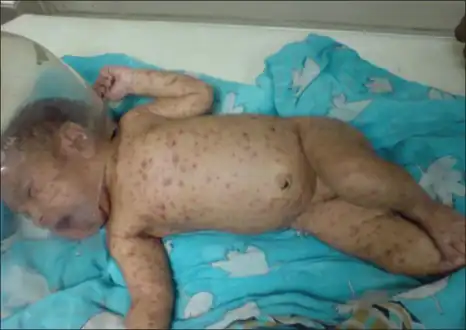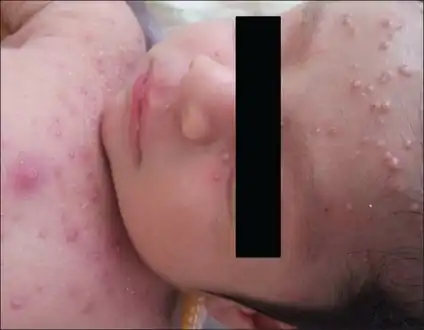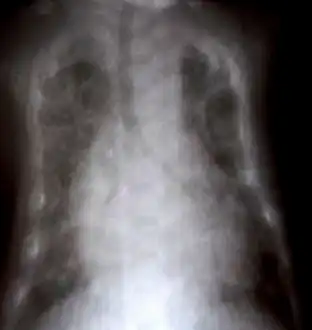Neonatal varicella
| Neonatal varicella | |
|---|---|
 | |
| Chickenpox exanthem (macules, papules, vesicles and crusts) | |
| Specialty | Pediatrics |
| Symptoms | Fever, spots, small bumps, small blisters, crusting |
| Complications | Pneumonia, hepatitis, meningoencephalitis, death[1] |
| Usual onset | Birth[2] |
| Causes | Varicella zoster virus in late pregnancy[2] |
| Risk factors | Chicken pox in late pregnancy[2] |
| Diagnostic method | Visualisation, PCR of blister swab[1] |
| Differential diagnosis | Neonatal herpes[1] |
Neonatal varicella is chickenpox infection in a newborn baby.[2] Symptoms may be present at birth or begin a few days later, typically with a fever followed by an eruption of spots that become small bumps which progress to small blisters before crusting.[1] These spots generally start on the head, and appear at various stages of development, before usually healing over a course of a week to ten days.[1] Complications include pneumonia, which may lead to death of the baby.[2] Other complications include hepatitis and meningoencephalitis.[1]
An affected baby typically contracts the Varicella zoster virus from their chickenpox affected mother during delivery, via direct contact with blood and chickenpox spots.[2] Less commonly, infection may occur via the placenta in the 20 days before birth, or just after birth by direct contact with respiratory droplets or skin.[2] When an unborn baby is infected in early pregnancy, it may result in congenital varicella syndrome.[1] Neonatal varicella may be more severe with a risk of death of 30% if the mother develops chickenpox between the five days before giving birth and the two days after.[1][3] Babies born After 5 days of the mother's onset of chickenpox are generally expected to have milder illness due to the mother's antibodies having crossed the placenta.[3] Diagnosis is by visualisation and a history of maternal varicella, though PCR of swabs of the blisters may help if uncertain.[1] Neonatal herpes may appear similar.[1]
Prevention is by vaccinating women who are not immune to chickenpox with the chickenpox vaccine.[2] Administering VZIG may prevent the disease in an exposed baby.[1] IVIG and aciclovir are alternative preventatives.[1] Treatment includes isolation and aciclovir.[1] Breastfeeding can continue.[1]
The infection presents in up to half of babies born to mothers infected with varicella in the last three weeks of pregnancy.[2]
Signs and symptoms
 Neonatal varicella (macules, papules, vesicles and crusts)
Neonatal varicella (macules, papules, vesicles and crusts) Neonatal varicella (macules, papules, vesicles and crusts)
Neonatal varicella (macules, papules, vesicles and crusts)
Complications
 Chest X-ray: Diffuse interstitial syndrome in both lungs
Chest X-ray: Diffuse interstitial syndrome in both lungs
See also
References
- 1 2 3 4 5 6 7 8 9 10 11 12 13 14 Singh, Srijan; Sharma, Akash; Rahman, Mohammad Mozibur; Kasniya, Gangajal; Maheshwari, Akhil; Boppana, Suresh B (2022). "Congenital and Perinatal Varicella Infections". Newborn (Clarksville, Md.). 1 (3): 278–286. doi:10.5005/jp-journals-11002-0040. ISSN 2769-514X. PMID 36540194. Archived from the original on 2023-09-10. Retrieved 2023-09-09.
- 1 2 3 4 5 6 7 8 9 Blumental, Sophie; Lepage, Philippe (30 May 2019). "Management of varicella in neonates and infants". BMJ Paediatrics Open. 3 (1): e000433. doi:10.1136/bmjpo-2019-000433. ISSN 2399-9772. PMID 31263790. Archived from the original on 10 September 2023. Retrieved 8 September 2023.
- 1 2 Yeh, Sylvia H. (2022). "13. Varicella zoster virus infections". In Jong, Elaine C.; Stevens, Dennis L. (eds.). Netter's Infectious Diseases (2nd ed.). Philadelphia: Elsevier. p. 57. ISBN 978-0-323-71159-3. Archived from the original on 2023-09-13. Retrieved 2023-09-11.